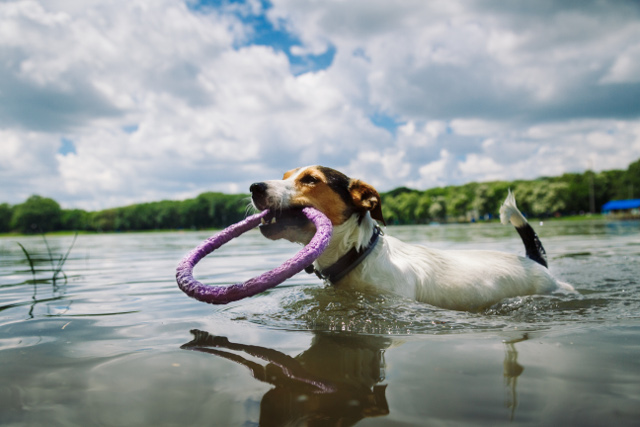Does your dog love the water? Many dogs will do anything they can to go for a swim, while many others will do everything in their power to stay dry. There’s no consensus among dogs about whether they like the water. Here’s a big question, however: can all dogs swim?
Understanding different breeds and their abilities to swim
There are a handful of dog breeds that have been selectively bred to be experts in the water. For instance, retrievers have been trained for generations to go into the water to grab birds for hunters, while dogs such as Irish Water Spaniels have developed waterproof coats so they can work in the fields.
These breeds are generally believed to know how to swim the second they lay eyes on a body of water, and will usually be happy to do so since their physical structure is perfect for swimming. Other breeds often prefer not to swim, or simply don’t see the point.
Some of the dogs that most love the water are:
- Labrador retrievers
- Toller retrievers
- Portugese water dogs
- Irish water spaniels
- Poodles
- Newfoundlands
- Irish setters
Regardless of whether your dog likes to swim or not, you should know that with a little preparation and training, all dogs are capable of swimming. This is especially good to know in the summertime, when dogs are at a higher risk of overheating and dehydration. If you can safely get your dog accustomed to being in the water, they’ll have a good option to keep cool in the warmer months. Swimming is also great exercise for dogs, and is a fun time for everyone involved.
So for those of us with dogs who aren’t natural swimmers, how can we safely introduce them to swimming and get them more comfortable in the water?
How to teach your dog to swim
It can be a little difficult getting your dog into the water especially if they’re not accustomed to swimming, but once you do, you’ll both be experiencing the benefits in no time. So where to begin?
There are a number of avenues you can take when teaching your dog to swim, and choosing which one to use depends mainly on your dog’s breed. While some dogs, like the ones mentioned before, are natural-born swimmers, others are just not able to excel in the water due to their biology. Bulldogs and Dachshunds, for instance, often don’t have the physical build to keep themselves afloat, and will likely need extra help with a floatation device.
Even if your dog is meant to be a capable swimmer, each pup is a little different, and yours may not be as keen on swimming as they’re ‘supposed’ to be. Whatever the case, it’s important that you understand your dog’s lineage and capabilities, set your expectations accordingly, and don’t be disappointed if your dog still prefers dry land over water.
Invest in a life jacket for your dog
When introducing a dog to the water for the first time, it’s vital that the dog finds swimming fun and not scary. You want to do everything you can to get your dog feeling confident in the water, and one great way to do that is to ensure they can’t sink. Life jackets for dogs come in all shapes and sizes for a variety of breeds and weights. Assuming their life jacket fits well, your dog will be able to focus on the mechanics of swimming, rather than struggling to stay afloat.
Even if your dog is a capable swimmer, a life jacket is never a bad idea. Even the strongest swimmers can get tired, and if you’ve ever thrown a ball for certain breeds, you know that many dogs will over-exert themselves to the point of danger if they’re allowed to. A life jacket allows them to not work as hard while still staying afloat, which will keep them safe as well as feeling confident.
When choosing a life jacket, ensure it’s the right size, and that it can be adjusted to fit your dog perfectly. Bright or reflective material is also a plus, since they’ll help you spot your dog in the water more easily. You should also look for a life jacket with a sturdy handle on the back. This will allow you to pull your dog out of the water if they’re struggling, guide them as they learn to swim, or even simply keep hold of them on the beach.
Make a plan for swimming lessons
Once you have all the equipment, it’s time to figure out your method for teaching your dog to swim. Every dog is different, so you’ll know better than anyone what you need to do to keep them feeling comfortable. With that said, a good idea for all dogs is to ensure that they’re the ones to enter the water. This can be achieved by throwing a floating toy into the water, or getting in yourself and encouraging them to come out to you. When a dog enters the water on their own terms, they’ll be less likely to become afraid. Start in the shallows, and don’t try to make your dog move deeper until they seem comfortable.
Every time your dog comes out of the water while they’re learning, you should reward them with a treat, a toy, or affection. This will help them form a positive association with swimming, and encourage them to get in the water next time.
Give your dog a demonstration
If you know anyone with a dog who’s already a confident swimmer, consider arranging a time for your dog to watch them swim. With your dog in a life jacket, they’ll be able to follow the other dog around, observing their technique and having a great time while doing it. After a few playdates in the water, your dog may feel more confident about swimming on their own.
Keep water safety in mind
Beyond the risk of drowning, there are a handful of other potential hazards for your dog in the water.
- Cold water. Too much exposure could lead to hypothermia, which is dangerous.
- Swallowing too much water. This is possible while your dog swims and grabs toys. If your dog is regularly vomiting after swimming, they’re swallowing too much. To counteract this, try to keep swimming sessions to about ten minutes, and choose a water-toy that they can easily pick up without ingesting too much water in the process, such as a flat, floating disc.
Don’t push your dog too far
Despite our best efforts, some dogs never really take to swimming. Even with all the floatation devices, training, and safety measures, some dogs simply don’t like the water. If you’ve been trying to get them interested in swimming for some time and aren’t making any progress, it may be that your dog just doesn’t like to swim. If that’s the case, don’t feel the need to continuously push them. There are still ways you can help your dog enjoy the water and keep them cool in summer.
Hopefully these tips will help you and your dog to enjoy the water in the warmer months. With some time, care, and preparation, most dogs will gradually come to love swimming. If you have more questions about how to safely teach your dog to swim, or anything else pet-related, feel free to contact us today.






